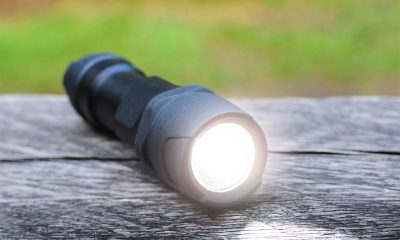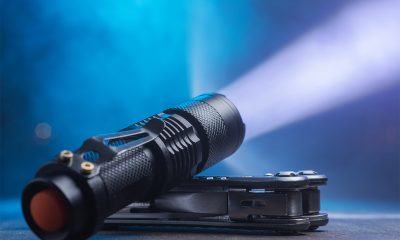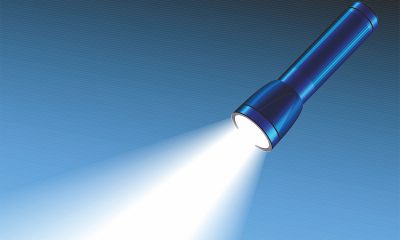Hands-free illumination
A headlamp is a battery powered light worn on the head, fastened to the hard hat or mounted on the helmet to provide hands-free illumination for a wide variety of activities including running, hiking, climbing, jogging, bicycling, camping, spelunking, late-night fishing, and daily works and tasks that require bimanual coordination.
As solid state lighting blows its predecessors out of the water, the usability of headlamps has been improved enormously. LEDs convert electrical power to visible light through injection electroluminescence as a result of electron-hole recombination within a semiconductor chip and use a wavelength converter to broaden the bandwidth of the emitted light for a spectrum optimal to the human vision. This emission mechanism brings about significant improvements source efficiency over conventional technologies, making it possible to create battery powered lights that can be a workhorse day in and day out. The small source size of LEDs enables design of low-profile, lightweight products for comfortable use. The inherent reliability of LEDs and their solid state durability contributes to peace-of-mind use over an awesome length of lifespan.
Configurations and features
LED headlamps come in various forms and configurations. A major design consideration with headlamps is the structural relationship between the battery and light head. These two components are often integrated into one assembly but it’s not uncommon to see headlamps with an independent battery pack. While the integrated construction reduces visual clutter, an independent battery pack can accommodate higher capacity batteries and be mounted on the rear of the head band to better distribute the weight. An LED headlamp uses at least one phosphor-converted LED to produce white light and a red LED for preserving night vision and signaling (SOS) beacon light in case of an emergency.
Most of the products on the market offer flood and spotlight options. In single-white-LED products, a hybrid optical system may be used to switch between a far-reaching spot beam and a close-range flood beam. Beam adjustment is generally accomplished using a zoom lens which is adjusted by simply rotating the head of the flashlight (the bezel). Some products are equipped with multiple white LEDs to perform the spotlighting and floodlighting functions independently.
Light source
LED headlamps are offered in lumen packages typically ranging from 100 to 2,000 and high power LED headlamps can deliver up to 6,000 lumens. The primary source of white light is a high power LED that combines high light output, high efficacy and high reliability to enable high lumen operation not possible with mid-power LEDs. The high power LED is often a ceramic package but the chip-scale package (CSP) promises to become an increasingly dominant technology for high lumen lighting applications. Both ceramic and CSP high power LEDs are constructed with a high efficiency thermal path that facilitates heat transfer by conduction from the active region of the LED to heat sink. Due to the low thermal resistance and the absence of plastic package materials these high power LEDs pack a powerful punch in a compact package.
For most headlamp brands, Cree LEDs have been a staple in the high power LED market and the most favored light sources for headlamps. Cree LEDs are built on Cree’s industry-leading silicon carbide (SiC) technology which creates fewer thread dislocations and thus and results in more light extraction when compared with GaN-on-sapphire LEDs. Along with higher thermal conductivity of a SiC substrate as well as advancements in epitaxial structure, chip architecture and wavelength conversion technology, Cree LEDs outshine the rest of the competition when it comes to luminous efficacy, lumen maintenance and color stability. The floodlight module may also use COB LEDs. The enormous advantage of the COB technology lies in the uniformity of light distribution, which is a key design requirement for floodlighting.
Battery technology
LED headlamps operate on either USB rechargeable batteries or alkaline/lithium primary batteries. Today, rechargeable batteries have seized a significant market share due to their convenience of use and low total costs of ownership (TCO). There are three types of chemistries to choose from for portable lighting applications: nickel cadmium (NiCd), nickel metal hydride (NiMH), and lithium-ion (Li-Ion). Each battery chemistry comes with its advantages and disadvantages, but the rechargeable lithium battery is currently finding widespread application in headlamps and flashlights due to its multiple significant benefits over alternative battery chemistries.
Lithium-ion batteries carry a very high energy density which outperforms NiCd and NiMH batteries by a factor of nearly two, and they operate for at least three times longer than alkaline batteries of the same size. The very high energy density of lithium-ion batteries compensates for their small size which makes great sense when they’re used to power headlamps. Lithium batteries do not have a memory effect and have a high cell voltage, low self-discharge rate, fast charging rate, long cycle life and deep-cycling capability. Protection circuitry, however, should be built into any lithium-ion battery pack to monitor and control battery operation, prevent the cells in the battery from being over-charged and over-discharged, and minimize the risk of thermal runaway due to exposing the battery to elevated temperatures.
Rechargeable headlights are usually equipped with 14500, 16340, 18650 or 21700 Li-Ion batteries. Some products use lithium polymer (LiPo) batteries for a low-profile design. A LiPo battery is a solid state lithium-ion battery that uses a solid polymer electrolyte (SPE) and usually comes in a soft package or pouch format. The primary batteries are AA or AAA sized. CR123A batteries are non-rechargeable lithium batteries that provide a greater deal of power than alkaline batteries and are more cold resistant than rechargeable lithium-ion batteries. These batteries have enjoyed decent popularity as a power source for headlamps.
Driver and control circuitry
Central to the functionality of an LED headlamp are the driver/control circuitry, control configurations and the user interface. A DC-to-DC converter or charge pump provides a regulated voltage and current to drive an LED load. It steps up the voltage when the battery voltage goes lower than the LED forward voltage. The driver circuit is controlled and programmed through use of a microcontroller which provides control logic and other functionality required for operating the LEDs in different lighting modes.
Lighting modes available on an LED headlamp include, but not limited to, variable light output (high, medium, low, turbo), steady red, and strobe lighting in white or red. A push button switch or light control dial allows the user to cycle through the different lighting modes. A last-mode memory features keeps the last mode used in memory until the next use. For added convenience an infrared sensor may be used to enable hands-free operation with wet, dirty or gloved hands. A battery capacity indicator shows remaining battery power and charge status.
Bluetooth connectivity for wireless access from a smartphone app to monitor battery status, define activity profiles and customize lighting. Some products have a light sensor that measures and analyzes the ambient light in order to automatically adjust the brightness and beam pattern for optimized use of battery power.
Thermal management
Headlamps are often constructed to be lightweight, impact resistant, and conducive to thermal management. The housing is therefore commonly made of a thermoplastic polymer such as polycarbonate or ABS. Higher wattage LED systems generate a substantial amount of heat that must be dissipated with a high performance aluminum heat sink. Thermal isolation between the light head and human head should be provided to prevent the heat dissipated by the housing/heat sink from causing discomfort to the skin.
User comfort
The light head can be tilted to vary the beam direction and simultaneously create an air gap between contacting surfaces for minimized thermal stress to the human body. An adjustable head strap should be made for a comfortable and secure fit while being maximally skin friendly.
Ingress and impact protection
Headlamps are thoroughly sealed to a minimum ingress protection rating of IP66 at all points of entry and material transition to exclude water, moisture, dust, contaminants and insects. The impact resistance of an LED headlamp can be up to 2 m.















Loading...